#deciduous forest mammals
Text

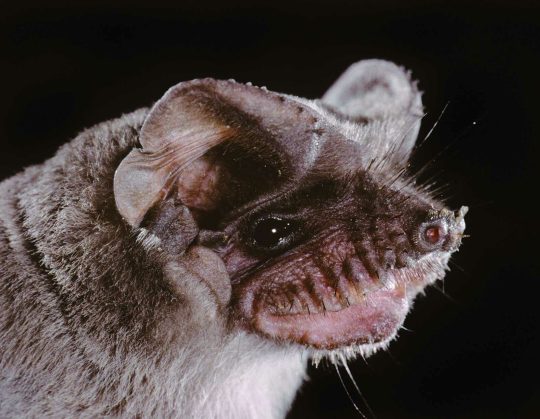

Fly Free with the Mexican Free-tailed Bat
Also known as the Brazilian free-tailed bat, guano bat, or Tadarida brasiliensis, this member of the order Chiroptera is one of the most widely-distributed New World bat species. They are common throughout the southern United States, Central America, and western South America. In many parts of the southern United States, the species is migratory and moves to Central America for the winter. They roost primarily in caves, but can also build nests in buildings; because of this, they can be found in a range of habitats including tropical and deciduous forests, mountains, deserts, and urban areas.
Like most bats, the Mexican free-tailed bat is nocturnal, emerging at sunset to hunt. They are primarily insectivores, and will travel great over 31 km (50 mi) to find food. In fact, this species holds the record for both the highest recorded flight altitude-- at 3.3 km (2 mi) high-- and the fastest flight speed-- an astounding 160 kph (99.4 mph)! That makes the Brazilian free-tailed bat the fastest mammal on Earth, although they can only achieve those top speeds in short bursts and with a good tail wind. Moving that fast can be useful, not only for covering great distances or catching insects, but for avoiding predators like raptors and owls. Young bats that can't fly may also be susceptible to opossums, skunks, and snakes.
The roosts of T. brasiliensis can be quite large; many contain several thousand individuals, while some have been recorded as housing more than a million. For this reason, communication is very important. Mexican free-tailed bats use echolocation to navigate and, for mothers, to locate their young. This species has over 15 distinct calls just for socialization. In addition, they can use their vocalizations to 'jam' the echolocation of other rival species and steal their prey.
Mating for the Brazilian free-tailed bat occurs once a year in the spring. Females gather in large maternity groups, while males mark out a territory by urinating and emitting loud vocalizations. Once a pair mates, the two separate- often to seek out another partner. Gestation lasts 11-12 weeks, and once females give birth they leave their offspring in a group of pups known as a creche, that is cared for communally. The pups take 4-7 weeks to be weaned, and after they learn to fly they join the larger roost as independent adults. However, females take up to 9 months to become sexually mature, while males may take as long as 2 years. In the wild, an individual may live as long as 8 years.
Size-wise, T. brasiliensis is on the smaller side of the bat group. Most individuals are around 9 cm (3.5 in) in length and weigh around 7–12 g (0.25–0.42 oz), with a wingspan of 28 cm (11 in). Females tend to be slightly heavier, but not larger otherwise. The tail of the Mexican free-tailed bat accounts for nearly half its total body length, and is unconnected by the thin membrane that makes up its wings (the uropatagium)-- hence the name 'free-tailed'. The ears are large and rounded, to assist with echolocation, and the muzzle is heavily wrinkled to give them a wider gape when catching bugs in mid-air. The Brazilian free-tailed bat's fur is dark brown or gray, with no distinguishing features save the long, white bristles around their feet.
Conservation status: The IUCN has classified the Mexican free-tailed bat as Near Threatened. However, populations are declining due to habitat destruction and susceptibility to a fungus known as white nose syndrome. Governments in the southern United States and Mexico, as well as private NGOs like Bat Conservation International, have established laws and conservation areas to protect the species.
If you like what I do, consider leaving a tip or buying me a kofi!
Photos
Michael Durham
Merlin D. Tuttle
Carlos Russi
#mexican free-tailed bat#Chiroptera#Molossidae#free-tailed bats#bats#mammals#generalist mammals#tropical forest mammals#deciduous forest mammals#wetland mammals#desert mammals#north america#southern north america#central america#south america#western south america
118 notes
·
View notes
Text
A writer’s guide to forests: from the poles to the tropics, part 7
Is it no.7 already? Wow. A big shout out to everyone who has had the patients to stick with this. Now onto this week’s forest…
Dry forest
Water is life. That’s a fact. And especially where it doesn’t rain for more than half the year.
Location: Dry forests are scattered throughout the Yucatán peninsula ,South America, various Pacific islands,Australia, Madagascar, and India. Areas have been cleared by human activity, and the SA dry forests are classified as the most threatened tropical forests.
Climate: Temperate to tropical, with just enough rain to sustain trees. Many are monsoonal, with rain coming in one or two brief periods separated by a long dry season.
Plant life- Hardy trees, such as Baobab and Eucalyptus are able to last with little rain by tapping into groundwater with extensive root systems. Many trees are evergreen, but in India, many species are deciduous. Trees are often more spaced out, and shrubs and grasses grow extensively. Cacti are common plants in the Americas, with some growing tall enough to be considered trees. In order to survive the heat and lack of water, many small plants are annuals, or store water in tubers. Palms can make up a large percentage of the trees, as was the case in the now vanished forests of Easter Island.
Animal life- As they can come and go when they please, birds are common species. Larger animals are active year round, with smaller species of mammals, amphibians, and certain insects only coming out during the rainy season. Isolation means that islands become home to many endemic species; think about Madagascar and the lemurs, or Darwin’s finches, iguanas, and tortoises in the Galapagos. Isolation has also led to the marsupials of Australia developing to fill the niches that would normally be occupied by placental mammals .The introduction of invasive species has brought about the extinction of island fauna.
How the forest affects the story- Water, or the lack of will be the biggest challenge your characters will face. Rivers and lakes may be seasonal, so other sources will have to be utilized. Drinkable fluids can be obtained from various plants and animals, or maybe the bedrock is porous and water accumulates in cenotes. Your characters could come from a culture that builds artificial reservoirs to collect the rain and store it for the dry season. With careful water management, cities can thrive in dry areas. But your characters will have to be careful. Prolonged drought will see societies go the way of the Maya. Deforestation leaves the topsoil vulnerable to the wind, and forests, farms, and grassland will inevitably turn to desert. Whether nomadic or sedentary, your characters and their society will have to find a way to interact with the forest without destroying it or themselves. Can they do it? Can a damaged biosphere be restored before it’s too late? The success or failure of your characters and/or their predecessors can be a driving focus of the plot. Of course ,when the rains do come, it could be in the form of a cyclone. Dry ground does not readily absorb water, and flash floods are a danger. Water can grant life, but it can take it as well.
#writing#creative writing#writing guide#writing inspiration#writing prompts#writer#writers#writing community#writer on tumblr#writeblr
47 notes
·
View notes
Text
The problem, [Frans Vera] explains, is that we have forgotten about the megafauna that would have been roaming our landscape before we arrived on the scene: large herbivorous mammals like the aurochs (the wild ox), tarpan (the original wild horse of Europe), wisent (the European bison), elk (known in North America as moose), European beaver and the omnivorous wild boar. All, according to fossil bone records, re-colonized the lowlands of Central and Western Europe along with red deer and roe deer about 2,000 years after the end of the last ice age – around 12,000 years ago. Trees, on the other hand – according to the pollen records – appear only between 9,000 and 1,500 years ago. So, oak, lime, ash, elm, field maple, beech and hornbeam – the key species of what is claimed to have been the primordial closed-canopy deciduous forest of Europe – arrived at least 3,000 years after the large herbivores. This is a very different picture to the one that has rooted in our mythology. It flies in the face of the received wisdom that closed-canopy forest is the natural habitat of these large animals. It also suggests – another heresy – that large herbivores played a part in, or at least did not prevent, the generation of trees in our landscape.
Isabella Tree, Wilding: The Return of Nature to a British Farm
99 notes
·
View notes
Note
Have you ever considered an environmental (or societal!) worldbuilding post for Taur-im-Duinath? There's so little in canon, I'd be fascinated to know your headcanons.
(This is a somewhat selfish ask as I am writing a fic that will have a significant portion set there, but genuinely love reading your posts -- no rush or pressure on this!)
Environmental World Building Masterlist
Taur Im Duinath is a large forest located in southeast Beleriand. Its name translates to Forest between rivers as it is located between the river Sirion (on the west) and the river Gelion on the east. In its southern reaches on the western border it extends to the lands around the Bay of Balar. The Andram, the wall of rocky hills ending with Amon Ereb in the east, lies directly to the north of Taur Im Duinath
As you said, it is mentioned very little in The Silmarillion, only twice actually. This corner of Beleriand is described as dark, tangled and wild with no elven or human inhabitants save some Avari
It can be difficult to judge exact sizes on Tolkien’s maps but Taur Im Duinath appears to be one of the largest forests in Beleriand
My thoughts
These are more general thoughts and for flora and fauna I gave examples of genuses or families rather than species but if you give me specific categories I can make more detailed posts!
-The climate is not as mild as Ossiriand but is far more mild than northeast Beleriand. The winters do not generally drop below negative one degree Celsius or thirty degrees Fahrenheit. Snow falls lightly in mid winter with sleet often occurring before and after.
-Humidity is higher than the rest of eastern Beleriand excepting parts of central Ossiriand with high rainfall especially in late winter and spring.
-The forest is dense. It is deciduous and coniferous mixed forests with scattered swampier areas which tend to be slightly more open. Most plants must be shade tolerant.
-There is an undergrowth of a variety of species of mosses and ferns as well as fungi. Some species of extremely shade tolerant herbaceous plants grow as well as a wider variety in the wetlands, scattered clearings, and forest edges
-The conifers are primarily spruce, Asian pine, with some fir and even cypress closer to the bay. Tsuga dumosa, a species of hemlock, grows closer to Ossiriand
-The deciduous trees are primarily birch and several species of oak. Ash and tilia species also grow
-Willow and aspen grow in the wetlands and closer to the river with some alders and a few wych elm.
-Animal biodiversity likewise varies throughout the large region. High diversity of small birds, mostly passerine but also nightjars, owls, a few species of ground birds, etc.
-The undergrowth provides habitat for the highest diversity of animals. Lots of Orthoptera (crickets, grasshoppers etc) so the forest is rarely quiet though the dense canopy muffles the sounds. Also high diversity of beetles, worms, rolly pollys, snails and slugs, and then toads, salamanders and newts, certain species of wood frogs, and small mammals like shrews especially by the water
I hope this is ok, @polutrope! I wasn’t sure what areas to focus on so please feel free to ask for more specific areas!
21 notes
·
View notes
Photo


March’s Fossil of the Month - Acanthostega (Acanthostega gunnari)
Family: Acanthostega Family (Acanthostegidae)
Time Period: 365 Million Years Ago (Late Devonian)
In life, Acanthostega gunnari would have likely resembled a cross between a lungfish and a salamander, and this isn’t dramatically different to what it really was; Acanthostega was a stem-tetrapod, an early member of the lineage of animals that now contains all reptiles, birds, mammals and amphibians, and is believed to be an example of a key stage in the transition between fleshy-finned fishes and the earliest terrestrial vertebrates. Although it possessed 4 short limbs ending in wide, 8-toed feet, the lack of any clear wrist or ankle joints suggests that Acanthostega likely couldn’t support its weight on land, and this combined with its well-developed pelvic bones implies that it was likely a fully-aquatic animal that primarily relied on a paddle-like fin on its tail to propel it forwards while its limbs were used to steer or possibly to grasp aquatic vegetation. During the late Devonian much of the world (including the area of what is now Greenland where Acanthostega fossils were first discovered) was covered in humid, swampy deciduous forests, and this combined with Acanthostega’s anatomy suggests that it likely inhabited warm, oxygen-poor forest pools, which would also explain one of its more unusual characteristics; in addition to possessing fish-like internal gills (as suggested by the presence of gill arch like structures at the base of its skull), a rudimentary rib cage implies that Acanthostega likely had lungs, allowing it to extract oxygen from water as well as air and thereby survive in shallow, oxygen-starved pools that fishes and larger stem-tetrapods would have struggled to breathe in. The teeth of Acanthostega (which were arranged in two rows and were short and sharp, with two larger fangs on the lower jaw) implies that it was likely carnivorous (possibly feeding on terrestrial arthropods caught from above-water beds of vegetation or the banks of its home pools), and comparisons of the anatomy and mineral makeup of fossils of smaller individuals (believed to be juveniles) with those of larger individuals (which are generally believed to be adults) implies that it grew slowly, possibly taking up to 6 years to reach full maturity (at which point most individuals were around 60cm/23.6 inches long, although the difference in the length of seemingly mature individuals suggests that, as with many fish, adverse environmental conditions could considerably limit Acanthostega’s growth.) Although it is unlikely that Acanthostega or its descendants ever succeeded in colonizing land, it is generally accepted that (having become so well-suited to life in the oxygen-poor pools they inhabited) they had little need to, and as several of Acanthostega’s fellow stem-tetrapods (such as the significantly larger Ichthyostega, which had jointed, six-toed limbs and a more developed rib-cage that likely allowed it to haul itself onto land for prolonged periods like modern mudskippers or seals) are known to have done so, the study of the anatomy and lifestyle of this strange little swamp-dweller can still help to shed light on how the variety of land-dwelling vertebrates seen today came to be.
--------------------------------------------------------------------------
Image Sources
Fossil: https://commons.wikimedia.org/wiki/File:Acanthostega_gunnari.jpg#/media/File:Acanthostega_gunnari.jpg
Restoration: https://www.10tons.dk/acanthostega-gunnari
#Acanthostega#acanthostega gunnari#animal#animals#prehistoric animals#wildlife#prehistoric wildlife#devonian wildlife#zoology#biology#paleontology#stem-tetrapod#stem-tetrapods#evolution
94 notes
·
View notes
Text
🐾 Daily Animal 🐾
The animal of the day is...
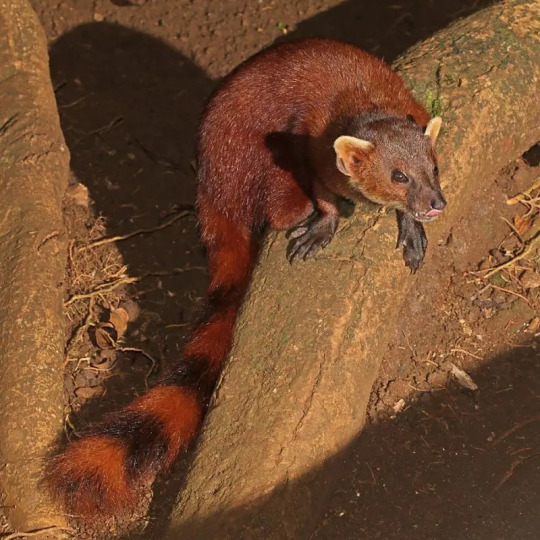
Ring Tailed Vontsira/ Ring Tailed Mongoose!
The ring tailed mongoose is a part of the eupleridae family, and galidia genus, with their specific species being known as the Galidia elegans- which fits them quite well as it translates to 'elegant young weasel'.
They have long slender bodies, with a rounded head and pointed snout. Their fur is dark red, they have black feet, and their tails have black and red bands similar to the red panda- and also give them their name.
These mongoose are found in Madagascar, living in both humid montane forest, and dry deciduous forest to the west.
They are diurnal, meaning they sleep at night, typically in tree cavities or burrows that they dig themselves.
They are very agile, good climbers and adapt swimmers. They can be quite playful, and social- usually they're found in pairs with up to three offspring.
Scent marking is a very important part of their communication.
Ring tailed mongoose are carnivores, with their diets consisting mainly of small mammals, invertebrates, fish, reptiles, and eggs- though they will occasionally eat insects and fruit.
Their population in the wild is unknown, however it is known that their number is decreasing due to habitat loss, hunting, and competition with other animals such as civets, dogs and cats.
However they are considered Least Concern on the IUCN Red List.
#animals#animal#animal info#ring tailed mongoose#ring tailed vontsira#animal facts#wildlife#wild animals#mammals#galidia elegans#max-talks-animals
8 notes
·
View notes
Text
Poogle Oogle Analysis 1/2
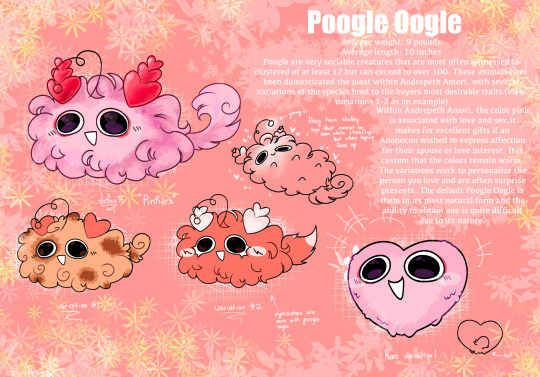
I made this creature a while ago, this will be one of many species relating to Andrepeth Amori. This will be into two parts; between the wild and domesticated Poogle Oogles :) Have fun reading!
Default
Introduction:
Poogle Oogles (or Oogles/Poogles) are small mammals and reside within groups of Poogle Oogles, formally referred to as a Gnat of Gawks or Gnat for short. These groups have at least 12 but can far exceed that with no clear limit. Their life expectancy on average is quite low, only 1-2 years and mainly inhabit the deciduous forests of Andrepeth Amori.
Appearance:
IMPORTANT- All wild Oogles appear the same, regardless of gender.
- Fur: Poogle Oogles naturally have thick and fluffy pink fur covering the entirety of their body. The fur is long enough to completely encase them to a point their actual body cannot be seen. Their face is a lighter pink in comparison to the rest of their fur and closely resembles the shape of a heart.
- Eyes: Their eyes remain unblinking and wide, hence the origin of their name. Their eyes are solitary and remain in place for the entirety of their lives. Poogles eyes are always black but retain a sort of ‘sparkle’ when looking into them.
- Skin: The skin itself is very soft and a pale cream or pink. Beneath all that fur, there are small flat sacks resembling a deep violet or purple.
- Legs: Poogles have extremely short legs that are not visible at any angle, other than if their belly is exposed to the sky. They are petite, pointy stubs with no significant features. Due to the fur’s length, it completely hides their legs, leading them to become sort of skittering clouds when walking.
- Mouth/Teeth/Throat: Their mouth will remain as a permanent smile, agape or not. The entirety of their mouth and teeth are black (but due to stylistic choices, I prefer to draw the interior of the mouth white). From the naked eye, the teeth will appear to not be there, that is because Poogle Oogles do not have teeth on their upper or lower jaws but instead pharyngeal jaws and teeth that lines the sides of their throat. These teeth are small and thin, but are quite jagged and sharp. They do not have a tongue either.
- Coeur Antlers: These are the sort of ‘horns’ to the Poogle Oogle, stacked on top of each other in a group of three as it is sorted from largest to smallest top to bottom. They are quite shiny and sparkly as well.
- Orb: This is a shiny sphere attached to a thin appendage they can control entirely, which has the tendency to create a sort of swirl as the Poogle develops. It tested to be made from the same properties of the coeur antlers. The orb is biolumiscent and expels a pale pink light.
- Tail: Poogle Oogle’s grow fluffy tails, twisting into a small swirl around the tip of the tail :)
- Ears: They have no visible ears.
- Nose: At the very surface of their skin, resting right above the mouth, lies two incredibly small holes that is functions as a nose. It’s not visible due to how small the holes are.
Properties and Functions:
- Fur: Their fur is quite luscious, being best described as soft, silky, and lightweight. The fur acts a barrier between them and potential predators as the fur is reported to have a foul taste. It also protects them during the colder seasons, as the fur will grow to become much denser and larger to keep them warm.
- Eyes: Poogle Oogles vision is actually quite poor due to the fact they are born slightly crossed eyed and their cornea’s being much denser and translucent rather than transparent. Their cornea’s are slick and hydrophobic, causing infiltrates, object or liquid, to slip off quite easily. If they are damaged, this runs the risk of permanent damage and in some cases, is able to blind the Poogle. From their perspective, it’s extremely blurry and only capable of viewing blobs of colors. However, they are not completely lost and familiar colors, such as a gnat will incline them to gravitate towards them. Despite that, their eyes are extremely good at picking up movement, no matter how insignificant it is. Even at a distance where they cannot comprehend specific details, they can tell if something or someone is moving. They do indeed have eyelids but those are only utilized when sleeping.
- Skin: There are small sacks resembling flat marbles at the surface of the skin. The texture can be best described as rubbery but smooth. They eject long, thin thorns when they detect the Poogle is being tampered with, as the sacks have an abundance of nerves. A telltale sign of this is an unnatural or unexpected touch to the fur and/or skin. This is an autonomic ability. These small sacks are filled with a venom containing a neurotoxin. This venom is administered when the Oogle’s thorns pierce the flesh of the attacker. This neurotoxin attacks the nervous system, weakening the muscles and bodily functions and used to paralyze their attackers. (Anonocons stabbed by their thorns report feeling fatigued and confused before the paralysis set in) It is not deadly, it only works to temporarily restrain their attacker. The neurotoxin works extremely quickly, in approximately 3 minutes but can work faster if there is a higher dosage.
- Legs: Poogle Oogles are much faster than they appear, their light fur allows them to move with surprising agility and speed.

- Mouth/Teeth/Throat: Their pharyngeal jaws can extend and retract out their mouth to clamp onto their prey. They are sharp and dig deep into flesh, and are quite durable and strong. Once they clamp onto their prey, it’s very difficult to get them off as they lock their jaws. Poogle bites are not uncommon in Andrepeth Amori. They have a slimy, gray saliva that they use to assist in sliding the food down their throat.
- Coeur Antlers: Coeur Antlers expel crimson spores that when inhaled, causing an increase in oxytocin and dopamine. These spores are used primarily for mating within their own species, alerting a fellow Oogle of their sexual desire. These can be expelled by both female and male Poogles. Breeding can come at any time, but it is mostly done during the aftermath of a cold season, with the cold, their numbers will decrease, thus done to replenish the population. But sex during the warmer days is out the question, as a way to sort of prepare for the oncoming loss in the gnat.
- Orb: This sphere can glow to the Oogle’s will. It mostly serves to lure potential prey to their demise, but can also be used to see better within the dark. Seeing a herd of glowing Poogles is not uncommon on Andrepeth Amori.
- Tail: Just a cute little attachment :)
- Ears: Poogle Oogles have no visible nor external ears. Oogles are essentially deaf, but they do have a method of sensing sound. Similar to snakes, they possess a manipulated columella, a small bone connected to the jaw bone, enabling them to sense and feel vibrations. This ability is vital for their survival as the footsteps of their prey notifies them of their location, allowing them to escape from potential predators. This skill is quite impressive and known to be extremely sensitive, the slightest shift, air or by ground, allows them to pinpoint exactly where you are.
- Nose: Contrary to it being nearly unviewable, Poogle Oogles can distinct scents from one another very well, even at a distance, they can pick up on particular odors. This is also vital for their survival, as injured animals are often a target of becoming ambushed once their scent is picked up. Not only that, but Poogles release a scent unique to their own species that only they can smell, a useful ability to make sure the Gnat stays together.
Magical properties:
Poogle Oogles are one of many animas that use magic on Andrepeth Amori, but this ability is limited to only one purpose; leaping and jumping. Their legs don’t allow them to naturally jump on their own, so they use a bit of sorcery to do so. Jumping is primarily used to ambush their prey by landing on their back or by gaining altitude to escape predators or dire situations. This is mainly done through summoning invisible trampolines that launch them into the air and allow them to sort of bounce around or travel to high places.
Diet/Hunting Habits:
Poogle Oogles are carnivorous creatures, but are capable of eating certain fruits or vegetation, but in no way take up a significant portion of their diet. They hunt during sunset and capture prey in Gnat of 20-25 Poogles via the glow of their Orb as a deceptive tactic. Once the prey is close enough, the others will pounce, many will attack via ground and or by jumping onto the prey’s back. It is then that they will clamp their jaws onto their flesh and by then, their prey is entirely swarmed.
Oogles have been reported to tear apart the flesh of their prey and consume them whilst they are still alive. There have been multiple instances of them pulling off their skin and burrowing inside the flesh to consume the organs. All of their prey is guaranteed to be decimated and left in a heap of bones or hardly recognizable. If the Oogles venom poisons their prey, the Gnat are not affected.
Gnat Relationship:
They value their species very much and rely on each other for survival, so there is no distinct social hierarchy in the species. Every Oogle you’ll see out in the wild is guaranteed to have a gnat nearby, but in very rare instances, can be separated by their group - mainly during weather crises. Poogle Oogles are very protective and territorial of their species and do whatever it takes to survive if it means the rest can survive. This comes to dire consequences at times as phenomenons such as cannibalism as a last resort if has become rash. Compared to other species, such as bumblebees, they will not kick out their own kind, but will eat them instead.
Reproduction and Growth stages:

When female and male intercourse occur between Oogles, a bae (or baby Poogle Oogle) will be born. A bae’s growth is never fluidly consistent with the species and based solely on the conditions of the environment they were born within and how well fed they were. If the food flow and care was consistent, a Poogle will grow healthily, but never at the same rate as others, even within their own nest. A Poogle is much more likely to die premature or stillborn if born during colder seasons or poor living conditions, it’s especially worse if the mother is not taken care of well enough.
On average, a mother will produce at least 5 baes for each litter they produce, but can exceed that, with the highest reporting to be 11. A pregnant Poogle will externally appear the same but their behaviors will differ, as she becomes much more susceptible to fatigue. Her and her mating partner will begin to prepare the nest for their children. The mother will stay in the nest for the majority of her pregnancy and the male partner will take priority over themselves to feed the female Oogle. On average, the female Oogle will give birth to two batches in her entire lifetime. There are 3 stages that an Oogle has in its lifetime - infant, adolescent, and adult.
Infancy - at this stage, a Poogle has a short layer of fuzz for fur, no antlers, no teeth and a very short orb. They are blind, have a heightened sense of smell, have their eyes closed, have a much harder time hearing and cannot walk. A bae’s cries can alert fellow prey and thus, the nursing Oogle are greatly protected by the Gnat and are given priority over anyone else. If a threat manages to break way into the nest, the two parents will place their young into their mouths and quickly flee. Mother Poogle Oogles will sing by a series of low purrs and hums to soothe and bond with their young. Despite their poor hearing, that is all they can properly hear. Fathers are also entirely present in their children’s lives and will go as far as to perform regurgitation if there is no sufficient food source. Mothers chew the food for their young into a paste before spitting it back up for her children to swallow; her saliva allows the food to slide down the infants throat as their own has not been developed. This is a required process as this runs the risk of the bae choking.
Adolescent - Their eyes have opened and will remain as such. Their antlers have begun to sprout, but are much more susceptible to damage and are much more skittish around the hint of danger. The adolescent is now capable of walking, but even this ability is a bit limited, so the young ride on the backs of their mothers and fathers until they learn to do it on their own properly. At this stage, a parenting Poogle is reported to be much more dangerous and hostile, known for snapping at Anonocons that get too close to them or their nests.
Adult - This is the stage they are most often witnessed to be on, their orb, antlers and fur has grown out entirely. At this stage, the Oogle no longer needs its parents and are free to leave the nest to create their own.
Elder? - Not an official stage, but long living Oogles (3+ years) have been observed to have been nearly blind, have poorer hearing, and the agility they once had as an adult is much worse. Once this is noticed by the Gnat, the Poogle Oogle cannibalise the ‘Elder Oogle’ as a way to savor resource for the inevitable colder seasons.
Communication:
As mentioned before, mother Oogles are capable of singing, but this is possible with all Oogles and is a method of both communication and greeting within the Gnat. When within the Gnat is when these sounds are most likely to be heard, especially when huddled together. But these are also sounds they make individual.
As a method of creating community and socialization reported by many researcher’s is the infrequent chance of a Gnat to congregate and heightened their purring into warbles, shrieks, and trills. Although the sounds on their own is rather adorable, these are sounds that have never been reported to be heard before other than during these phenomenons. Researchers dub these as ‘conventions’ due to their acts of togetherness and conversation to an extent. For reasons yet to be discovered, these events only occur during the night and at random intervals of the year. The shrieks can be quite terrifying to surrounding animals and many traveling Anonocons have reported witnessing these events. There is a common superstition that many travelers report; their shriek is directed toward the night sky and many scientists and researchers theorize they are practicing a method worship. Who or what that is directed at is unknown.
The tail will slowly sway when they spot potential, unrecognized movement, defaulting on their normally upright, stiff stance. This is meant to alert their fellow Poogles there is something or someone nearby moving, allowing them time to be on the defense if attacked. This swaying can increase to the equivalent of wagging; thumping. Their tail will begin rapidly move up and down, softly hitting the ground with their tail. This occurs when the Poogle experiences an increase of happiness or pleasure, such as the birth of a litter, but mainly during intercourse and once orgasm has been reached.
Sleeping:
Poogle Oogles sleep immediately after their final hunt during a sunset. By the time they have finished eating, nighttime would fall and the Gnat would seek a shaded, dark place of the forest to sleep. The Poogle Oogles will huddle tightly together and got to sleep :3
Impact on Andrepeth Amori:
Anonocons often consider wild Poogle Oogles more as an annoying pest than their domesticated counterparts. Although it is well documented fact that Oogles can be quite dangerous, they aren’t taken very seriously and being pricked by one can be easily dealt with. A wild Oogle making its way onto the busy streets is uncommon but not rare for Patrollers designated to keep such animals off the road. Their reputation is due to their large litters of baes, many have been reported Oogles being born en masse in a nearby forest, only for a hoard of them to raid the meat market and clean the entire stock - these opinions stem from the infuriated butchers and sellers who have to occasionally deal with their entire supply of goods being eaten in a matter of minutes. Down the line of their existence, Poogle Oogles have been domesticated and classified as exotic pets primarily owned by the rich.
This caused a lot of socioeconomic tension as although the domesticated Poogle Oogles present no harm to the butchers, seeing one is enough to make them mad. The rich are quite inconsiderate and are openly smug about their pets, some even proudly displaying them whilst in the meat market. Although butchers usually hold their tongue and bear it, there are few that go out of their way to target Poogles and will kill them, domesticated or not, if they manage to wrangle their way into their things or property.
Miscellaneous:
They cannot swim. Any Poogle who accidentally slips into a body of water and cannot escape is a guaranteed death for them. How they manage to maintain their skin and fur’s cleanliness is called into question - that is through rain.
7 notes
·
View notes
Note
Do you think they could boil eggs?
Easily! VERY easily. But it may not be done all too often because eggs would be quite valuable. It's a pivotal binding agent for cooking. Dough, meatloaf, kibble…
They don't have access to an egg-laying domestic bird like a chicken, so they would have to forage wild eggs. On top of it, they would want to avoid taking the eggs of vulnerable species like curlews and songbirds to keep their numbers high.
ShadowClan would actually have access to a lot of eggs in the Lake Territory, because pine forests are home to a lot of birds and insects, with fewer mammals than deciduous forest. RiverClan's ducks and swans would also give them lots to work with; which could be shared by RiverClan's marshes.
Egg-centric dishes would be deeeelicious, like deviled eggs, "egg salad" with chopped fish, omelettes, egg drop soup.... mmgh. I'll add an egg entry to the to-do list.
#Been thinking of making version 2 of the Lake Map redux#One that I can highlight for questions like this to show where in the territory reagents could be collected from#I want to squirrel away some money to commission someone for it though since I'd like a map better than my skills would allow#Warrior Bites#Clan Culture#Eggs#Bone Babble
132 notes
·
View notes
Text
Moth of the Week
Io Moth
Automeris io

The Io moth or peacock moth is in the family Saturniidae. The name Io comes from Greek mythology in which the mortal Io was turned into a cow by Hera for sleeping with Zeus. The eyespots are said to look like the eyes of a cow. The species was first described in 1776 by Johan Christian Fabricius.
Description Males have yellow to orangish yellow body, legs, and forewings with symmetrical brown patterned markings. On the hindwings are large black eyespots with a white center and surrounded by yellow, black, and red orange edges. Also on the hidwings are a large red orange edge on the edge closet to the body. Females have reddish-brown body, legs, and forewings with patterns in varying shades of brown. the hindwings are similar to those of the male but with maroon instead of red orange and a small light brown edge. Some hybridizations have resulted in variations in these hindwing eyespots.
Average wingspan: 75.5 mm (≈3 in)
Males have larger antennae
Females have larger bodies and wings
Diet and Habitat The io moth caterpillars first feed on the eggs they hatch from then their host plants. These host plants are a variety of grasses, herbaceous plants, shrubs, deciduous trees, and conifers. Some of these plants included the mulberry, pin cherry, willow, balsam fir, red maple, bastard indigo, wild indigo, American hornbeam, sugarberry or southern hackberry, button-bush, eastern redbud, showy partridge pea, sweetfern, flowering dogwood, and common hazel. Adults do not feed. This species’s preferred habitats are deciduous forests, thorn scrub, and suburban areas in continental North American. They range from Manitoba to Nova Scotia in Canada and from Montana to Texas and onward over all the eastern states in the United States.
Mating Io moths breed from late May to July, though southern populations may breed earlier and later in the season due to having several broods per seasons as opposed to the north’s single brood. The females emit pheromones to call males as soon as the second night after leaving the cocoon. Males detect female pheromones with their antennae and mating lasts for about 90 minutes staring around 9:45 to 10:30 pm. 3 to 5 days after mating, females lay their eggs in clusters of 20 to 35 on the host plants leave or stems. Eggs hatch after 8 to 11 days.
Average eggs laid: 300
Predators This species is harmed by many species of parasitic flies and wasps and hunted by birds, small mammals, and spiders. In defense, the caterpillars of the io moth have venomous spikes. This venom isn’t fatal to humans, but it does caus acute dermatitis. The adult io moths use their hindwing eyespots to scare off predators by shaking them to imitate a larger animal.
Fun Fact Adult moths are strictly nocturnal and rest on the branches or trucks of trees during the day.
(Source: Wikipedia, University of Florida, Missouri Department of Conservation, Butterflies and Moths of North America, Animal Diversity Web, Adopt and Shop, Kiddle)
#animals#bugs#facts#insects#libraryofmoths#moth#mothoftheweek#lepidoptera#Saturniidae#io moth#Automeris io#peacock moth
30 notes
·
View notes
Text
Pench National Park: Explore Wildlife Wonderland

Located in the southeastern foothills of the Satpuda Mountains, Pench National Park invites nature enthusiasts to explore its diverse ecosystems. The park, named after the winding Pench River, spans the southeast border of Madhya Pradesh and seamlessly extends into Maharashtra. Covering 758 sq km of pristine wilderness, it is divided into the 299 sq km Indira Priyadarshini Pench Nationwide Park and the 464 sq km Mowgli Pench Sanctuary.
For an immersive adventure in dense forests, encountering wildlife and marveling at nature's beauty, consider booking a Pench safari online. Ensure your reservation for an extraordinary journey into the heart of the wilderness.
Flora & Fauna at Pench National Park:
Pench's undulating hills and valleys are mainly covered by dry deciduous forest, transitioning to lush greenery near the Pench River. Dominant tree species include Teak, Mahua, Tendu, Flame of the Forest, Golden Shower, and Bamboo.
The park provides a habitat for 39 mammal species, 13 reptile species, and 3 amphibian species. Commonly sighted animals include chital, sambar, wild boar, jackal, Indian leopard, sloth bear, wild dog, jungle cat, and gaur. With over 300 bird species, including migratory birds, Pench offers a rich birdlife experience.
Location of Pench National Park: Spanning 758 sq km in the lower southern Satpura hills, Pench National Park is divided by the Pench River into Seoni and Chhindwara districts. Accessible near Turia Gate, Seoni district, Kurai, Madhya Pradesh, the park can be reached via air, road, and railway. Inquire or contact provided phone numbers for Pench safari bookings.
History of Pench National Park:
Declared a sanctuary in 1977 and a national park in 1983, Pench became the 19th tiger reserve in India. In 2011, it was recognized as the "Best Managed Park" by Madhya Pradesh Tourism. Pench's biodiversity has inspired renowned authors and, notably, Rudyard Kipling's classic 'The Jungle Book.'
How to Reach:
Nagpur airport (93 km) and Seoni Railway Station (30 km) serve as convenient entry points. Make an online Pench safari booking in advance for easy transit from these hubs. Buses and jeeps are available at Seoni bus stand for swift park access.
Lakes in Pench:
Explore Khokha Lake, Junewani Talao, and the picturesque lake area of Bodha Nala. Enhance your adventure with an online Pench safari booking, ensuring an immersive experience in renowned spots like Baghin Nala, known for tiger sightings.
Best Season to Visit:
Plan your Pench safari booking between November and May for a captivating experience. Note that the park remains closed in July, August, and September.
Land of Tigers:
Embark on a Pench jungle safari for a chance to witness the significant Bengal Tiger population, with approximately 40 tigers as per the latest Tiger Census.
Different Bird Species:
Experience vibrant birdlife at Pench National Park, home to over 210 species, including migratory birds. Book your Pench safari for an unforgettable encounter.
Other Animals:
Embark on a thrilling journey with a safari booking in Pench, home to approximately 39 mammal species, 13 reptile species, and 3 amphibian species. Encounter Chital, Sambar, Nilgai, wild boar, and Jackal among common wildlife sightings.
Why Make a Pench Safari Booking at Vannraj Resorts? Discover the reasons for a Pench National Park safari booking with Vannraj Resorts:
Immersive Jungle Experience: Expert naturalists guide you through Pench, sharing extensive knowledge about the diverse flora and fauna.
Night Safari Adventure: Explore Pench’s wildlife from a different perspective with knowledgeable guides.
Stargazing under the Pench Sky: Enjoy a mesmerizing stargazing session away from urban lights.
Wildlife Photography Tips: Learn valuable tips and tricks from experienced naturalists and wildlife photographers.
Luxurious Accommodations: Unwind in comfortable and stylish accommodations surrounded by the natural beauty of Pench at Vannraj Resorts.
2 notes
·
View notes
Photo





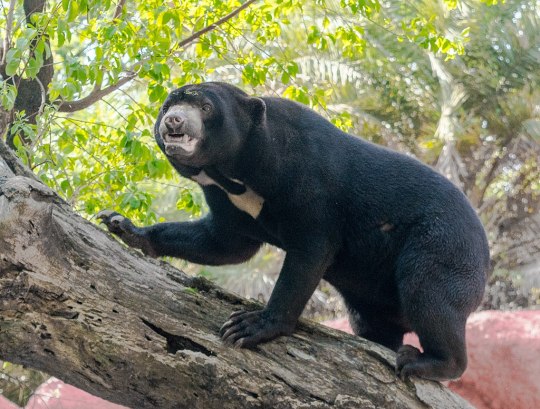


The sun bear is a species of bear in the family Ursidae and the only species in its genus Helarctos which is native to India, Bangladesh, Cambodia, China, Myanmar, Laos, Thailand, Vietnam, Brunei, Indonesia, and Malaysia. Here they are primarily solitary, diurnal, and arboreal creatures which live throughout both tropical deciduous and evergreen forests, and are often found 10 to 30ft off the forest floor and sleep inside tree cavities or under fallen logs. Sun bears are omnivores with a broad diet which includes nuts, fruit, seeds, sap, leaves, eggs, honey, nectar, grubs, bees, ants, beetles, termites, spiders, small birds, reptiles, and small mammals. Sun bears are themselves preyed upon by tigers, leopards, dholes, and reticulated pythons. Reaching 3- 4.5 ft (1- 1.3m) in length, and 55 -145lbs (25 to 65 kg) in weight, the sun bear is the smallest of all bear species. It is stockily built, with large paws, strongly curved claws, small rounded ears and a short snout. The fur is generally jet-black, but can vary from grey to red. Sun bears get their name from the characteristic orange to cream colored chest patch. Sun bears also sport inward facing paws better suited to climbing and incredibly long tongues which they use when feeding upon insects, honey, sap, and nectar. Sun bears are noted for their intelligence; with several individuals being observed to raid locked sugar store rooms by retrieving the keys and/ or picking the locks. Sun bears are polyoestrous; with breeding occurring year round. After a 95-240 day pregnancy (dependent on number of cubs) the mother will give birth to 1-3 cubs which will remain with there mother for up to 3 years. Under ideal conditions a sun bear may live upwards of 30 years.
5 notes
·
View notes
Photo
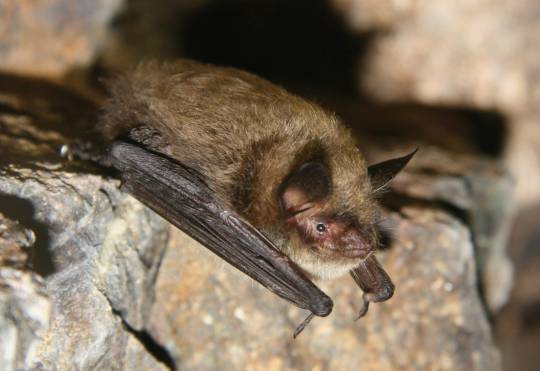


Going Batty for the Little Brown Bat
The little brown bat (Myotis lucifugus) is a species of mouse-eared bat that lives throughout North America, from northern Canada to the southern United States. They are most commonly found in deciduous forests, but they also roost in man-made structures or caves; anywhere warm and dark.
M. lucifugus is aptly named, as it’s a relatively small bat. At most, individuals weigh 12.5 g (0.44 oz) and have a wingspan of 27 cm (10.6 in). Females are typically larger than males. The color of their fur can range from tan or red to dark brown, though the fur on their stomachs is lighter than the rest of their body. In addition to their large ears, which gives them a great hearing boost, the little brown bat has exceptional eyesight and is sensitive to ultraviolet light. However, they lack a Jacobson’s organ, which in other animals is used to detect moisture-borne odor particles.
Like other bats, the little brown bat is primarily nocturnal, emerging at dusk and feeding intermittently throughout the night. Individuals emit about 20 calls per second while in flight, and use the corresponding information to avoid obstacles and detect prey. They feed exclusively on insects, including mosquitoes, beetles, and flies, and in a single night an individual may consume over 2/3 of its body weight in food. Because their source of food is generally seasonal, little brown bats are only active in the warmer months of the year. When the temperature drops to 0 °C (32 °F), individuals will enter a state of torpor, in which their heart rate may drop as slow as 8 beats per minute.
Mating takes place in the fall, just before the hibernation season. Males and females gather together in large groups to roost, in a behavior known as swarming. During this period, colonies average around 9,000 individuals; the largest recorded had over 180,000. Both sexes mate with multiple partners, and homosexual pairings are relatively common. This behavior continue throughout the hibernation period, and individuals will pair indiscriminately with active and torpid bats. Once mated, female bats store their sperm for the following spring; they then carry their pregnancies for 50-60 days. Each female gives birth to only one pup, which weighs about 30% of her body weight.
Pups grow rapidly, opening their eyes and ears within a few hours of being born and becoming completely weaned at 26 days old. After this, young transition to feeding solely on insects, though they may receive help from their mothers while learning the best techniques for catching prey. Females are sexually mature at only one year old, and males mature at two years old. Once they reach maturity individuals will leave to form their own roosting groups. In the wild, a little brown bat can live up to 34 years; however, many bats are predated upon by owls during the active season, and by raccoons while hibernating.
Conservation status: The IUCN has rated M. lucifugus as Endangered. Their primary threat is a fungus-caused disease known as white-nose syndrome; this disease is particularly harmful to the little brown bat due to their large congregations during the mating and hibernation period.
If you like what I do, consider leaving a tip or buying me a ko-fi!
Photos
Jason Corbett
Joseph Johnson
Rick Reynolds
#little brown bat#Chiroptera#Vespertilionidae#mouse-eared bats#microbats#bats#mammals#deciduous forests#deciduous forest mammals#urban fauna#urban mammals#caves#cave mammals#North America#queer animals#queer fauna
201 notes
·
View notes
Text
#1923 - Complex Rubus fruticosus - European Brambles

Unfortunately, figuring out exactly which Rubus is a problem, and that’s before we even start on the hybrids. For example there’s at least 15 species that grow in Australia, many of which are terrible weeds. Aotearoa also has three native blackberries, Rubus australis, Rubus cissoides and Rubus schmidelioides. This one was growing at Huka Falls - hopefully someone will remove it before it turns turns into a mass of impenetrable hedges.
Prickly, woody, clambering shrubs, usually deciduous, and if they have any positive features it’s the number with edible fruit. The more invasive species can swiftly occupy poorly maintained pasture, forest plantations and other disturbed areas. Sheep can become tangled in the sprawling canes and starve to death (and the backward-pointing thorns don’t help) and while goats will readily graze blackberry, and sheep will eat fresh growth, cattle avoid it. In addition to the prickles, spines, bristles, and gland-tipped hairs are also common - it’s almost like they don’t WANT their fruit eaten by large mammals.
Edible species include raspberries, blackberries, dewberries, and in North America, bristleberries. Popular hybrids include loganberry, boysenberry, marionberry and tayberry. Most are grown commercially with supports such as wires or canes, and are referred to as ‘Cane fruit’ or ‘cane berries’. Rubus fruit, sometimes called a bramble fruit, is an aggregate of drupelets.
2 notes
·
View notes
Text
Species: Foxes (Vulpes)
This series focuses on helping people choose interesting species for their fursona through informing them of the many, often overlooked, species out there! This post is about foxes.
──── ◉ ────
Bengal Fox (Vulpes bengalensis)

Size: 46cm (18in) lenght, 25cm (10in) tail lenght, 2.3-4.1kg (5-9lbs) weight
Diet: omnivorous, preys on invertebrates, small mammals, birds, reptiles; eats fruit
Habitat: scrublands, deciduous forests, grasslands
Range:
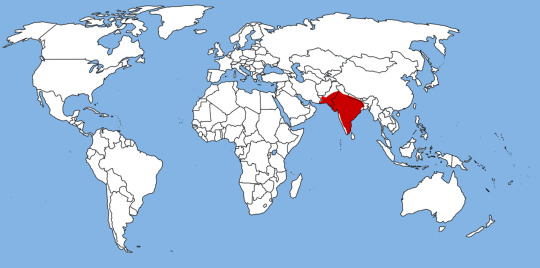
Status: least concern
──── ◉ ────
Blansford's Fox (Vulpes cana)

Size: 38-80cm (15-31in) lenght, 33-41cm (13-16in) tail lenght, 0.8kg (1.7lbs) weight
Diet: omnivorous, preys on invertebrates; eats capers, fruit
Habitat: mountainous deserts
Range:

Status: least concern
──── ◉ ────
Cape Fox (Vulpes chama)

Size: 30-35cm (12-14in) height (at shoulder), 45-60cm (17.5-24.5in) lenght, 30-40cm (12-15.5in) tail lenght, 2.5-4.5kg (5.5-9.9lbs) weight
Diet: omnivorous, preys on small mammals, invertebrates, birds, reptiles; eats carrion, fruit, tubers
Habitat: savannahs, dry grasslands
Range:

Status: least concern
──── ◉ ────
Corsac Fox (Vulpes corsac)
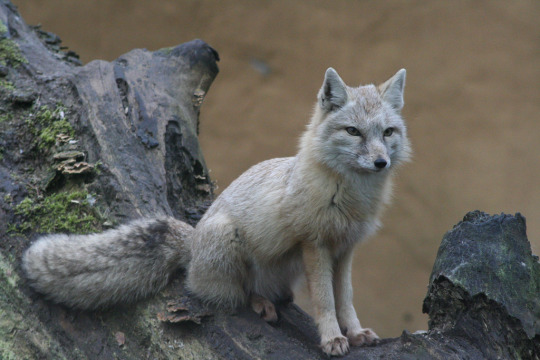
Size: 45-65cm (18-26in) lenght, 19-35cm (7.5-13.8in) tail lenght, 1.6-3.2kg (3.5-7.1lbs) weight
Diet: mostly carnivorous, eats small mammals, invertebrates; eats carrion
Habitat: steppes, semideserts
Range:
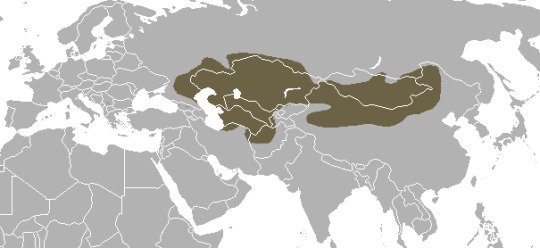
Status: least concern
Please note! The corsac fox has 3 subspecies!
──── ◉ ────
Tibetan Fox (Vulpes ferrilata)

Size: 60-70cm (24-28in) lenght, 29-40cm (11-16in) tail lenght, 4-5.5kg (8.8-12.1lbs) weight
Diet: carnivorous, preys on small mammals, reptiles; eats carrion
Habitat: semi-arid and arid grasslands
Range:

Status: least concern
──── ◉ ────
Arctic Fox (Vulpes lagopus)
Winter coat

Summer coat

Size: 25-30cm (9.8-11.8in) height (at shoulder), 41-68cm (16-27in) lenght, 30cm (12in) tail lenght, 1.4-9.4kg (3.1-20.7lbs) weight
Diet: omnivorous, preys on small mammals, fish, birds, invertebrates; eats carrion, berries, seaweed
Habitat: tundra, drift ice, boreal forests
Range:

Status: least concern
Please note! The arctic fox has 5 subspecies!
──── ◉ ────
Kit Fox (Vulpes macrotis)
The kit fox has 2 subspecies:
Vulpes macrotis macrotis

San Joaquin Kit Fox (Vulpes macrotis mutica)

Size: 45-53cm (17.9-21.1in) lenght, 26-32cm (10.2-12.7in) tail lenght, 1.6-2.7kg (3.5-6lbs) weight
Diet: mostly carnivorous, preys on small mammals, reptiles, invertebrates, fish; eats carrion
Habitat: desert scrubs, shrublands, grasslands
Range:
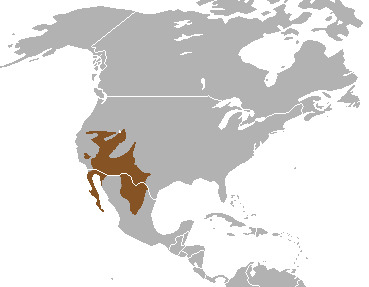
Status: least concern (V. m. macrotis), endangered (V. m. mutica)
──── ◉ ────
Pale Fox (Vulpes pallida)
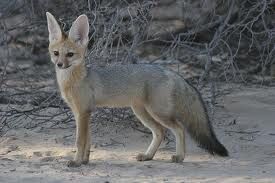
Size: 38-55cm (14.9-21.6in) lenght, 23-29cm (9-11.4in) tail lenght, 2-3.6kg (4.4-7.9lbs) weight
Diet: omnivorous, preys on rodents, reptiles, invertebrates; eats berries, other plants
Habitat: semideserts, savannahs
Range:

Status: least concern
Please note! The pale fox has 5 subspecies!
──── ◉ ────
Rüppell's Fox (Vulpes rueppellii)
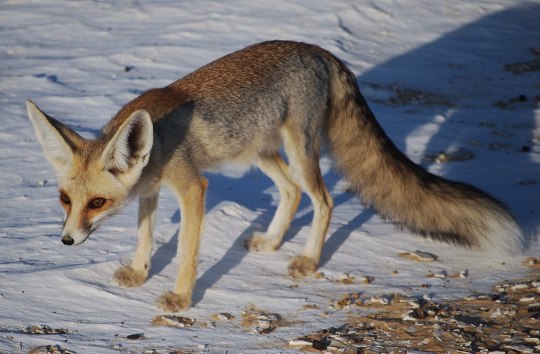
Size: 66-74cm (26-29in) lenght including 27-30cm (11-12in) tail lenght, 1.7kg (3.7lbs) weight
Diet: omnivorous, preys on small mammals, invertebrates, reptiles, birds; eats fruit, succulents
Habitat: sandy and rocky deserts, semiarid steppes, scrublands
Range:

Status: least concern
Please note! The rüppell's fox may have 5 subspecies (it is debated)!
──── ◉ ────
Swift Fox (Vulpes velox)

Size: 30cm (12in) height (at shoulder), 79cm (31in) lenght including tail
Diet: omnivorous, preys on small mammals, invertebrates; eats carrion, fruit, grasses
Habitat: prairies, deserts, grasslands
Range:

Status: least concern
──── ◉ ────
Red Fox (Vulpes vulpes)
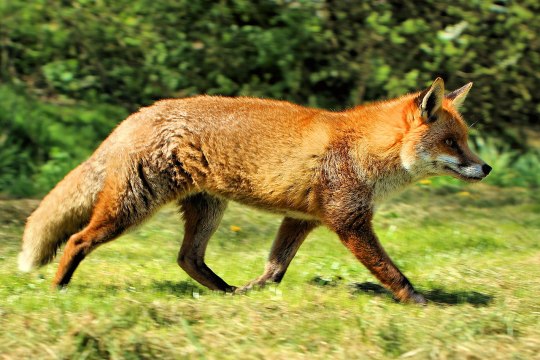
Size: 35-50cm (14-20in) height (at shoulder), 45-90cm (18-35in) lenght, 30-55.5cm (11.8-21.9in) tail lenght, 2.2-14kg (5-31lbs) weight
Diet: omnivorous, varied; preys on small mammals, birds, reptiles, invertebrates; eats carrion, berries, fruit, other plant material
Habitat: Literally Everywhere My God™
Range (green native, blue introduced, orange uncertain):
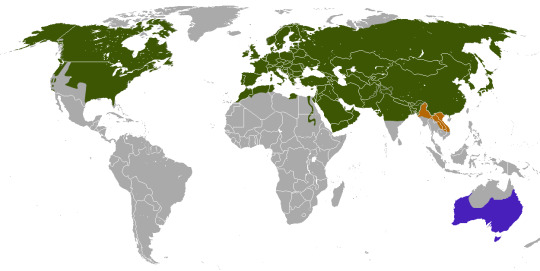
Status: least concern
Please note! The red fox has 45 subspecies!
Of which I would like to highlight:
Labrador Fox (Vulpes vulpes bangsi)

Arabian Red Fox (Vulpes vulpes arabica)

Kodiak Fox (Vulpes vulpes harrimani)
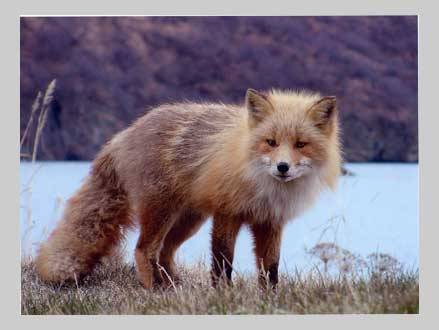
American Red Fox (Vulpes vulpes fulva)
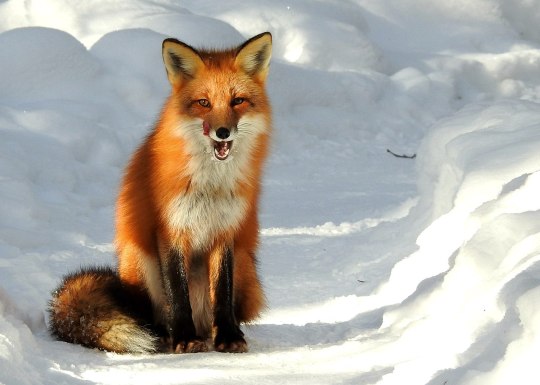
Please also note, there is color variation among red foxes regardless of subspecies
──── ◉ ────
Fennec Fox (Vulpes zerda)

Size: 34.5-39.5cm (13.6-15.6in) lenght, 23-25cm (9.1-9.8in) tail lenght, 1-1.9kg (2.2-4.2lbs) weight
Diet: omnivorous, preys on small rodents, reptiles, invertebrates; eats fruit, tubers
Habitat: deserts
Range:

Status: least concern
──── ◉ ────
#fursona resources#species#furry#fursona#fox#foxes#mammals#canidae#canines#vulpes#bengal fox#blansford's fox#cape fox#corsac fox#tibetan fox#arctic fox#kit fox#pale fox#rüppell's fox#swift fox#red fox#fennec fox
5 notes
·
View notes
Text
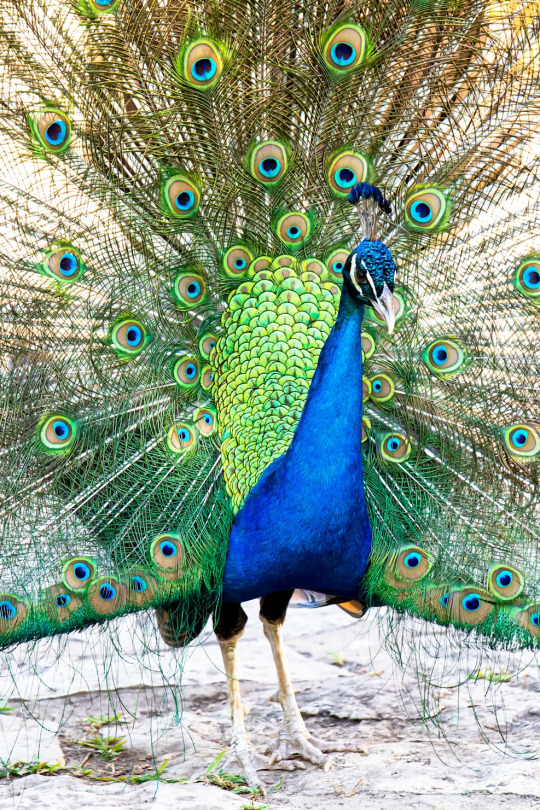
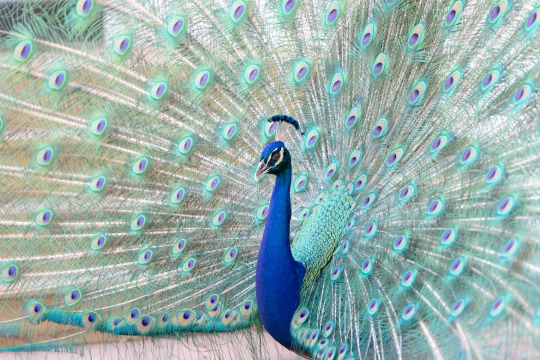
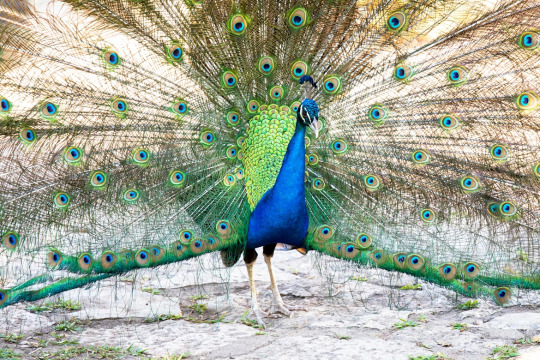

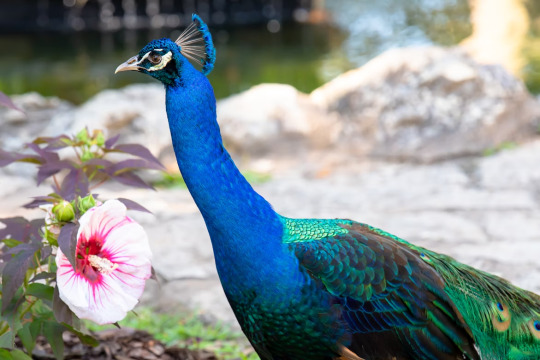
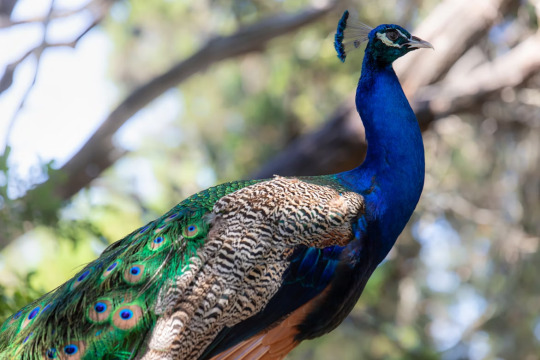
Indian Peafowl in Mayfield Park, Sugar Land, Texas, USA
Stephanie LeBlanc
The Indian peafowl, also known as the common peafowl, and blue peafowl, is a peafowl species native to India, Nepal, Bangladesh and Sri Lanka. It has been introduced to many other countries.
Conservation Status: Least Concern
Scientific name: Pavo cristatus
Lifespan: 15 years (In the wild)
Conservation status: Least Concern (Population stable)
Mass: 8.8 – 13 lbs (Male, Adult), 6.1 – 8.8 lbs (Female, Adult)
Length: 3.3 – 3.8 ft. (Male, Adult, From bill to tail), 3.1 ft. (Female, Adult)
Class: Aves
Domain: Eukaryota
Diet: Omnivorous. Eat seeds, insects, fruits, small mammals, and reptiles. They feed on small snakes but keep their distance from larger ones.
Habitat: They are quite resilient but prefer temperate or tropical deciduous forests with abundant roosting sites.
#Mayfield Park#Sugar Land#Texas#USA#Indian Peafowl#Peafowl#Birds#Wildlife#TXWildlife#US#United States of America#United States#North America
0 notes
Text
Prefix: Elder-
A black, red, or white cat.
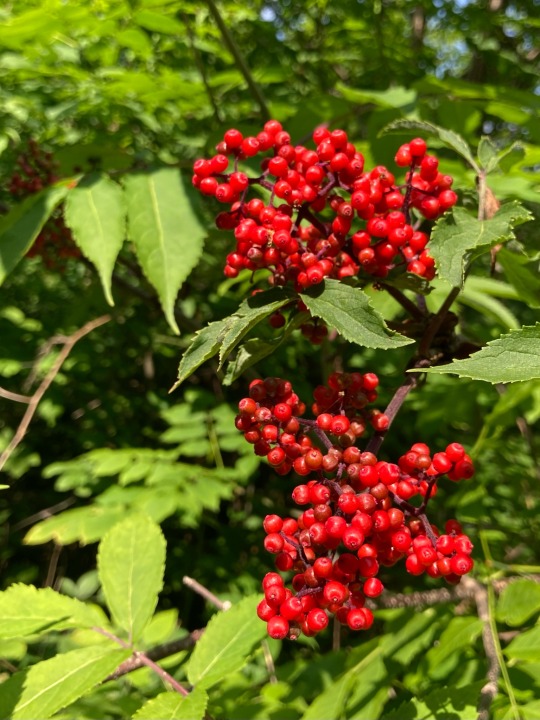
Description: elders are a genus of deciduous flowering shrubs that occur in temperate regions. Two species of elder, black elder and red-berried elder, are commonly found in Michigan. Both species have oppositely arranged compound leaves with five to nine leaflets per leaf. The leaflets are long with serrated edges and pointed tips, and they smell unpleasant when crushed. During spring, elders produce large clumps of small white flowers. Their fruits, called elderberries, ripen during late summer and early fall, and they attract many species of birds and mammals. As their names suggest, black elder plants have purplish black berries and red-berried elder plants have red berries. Elders can grow well in a variety of soil types and moisture levels as long as they have sufficient sunlight, and they can be found in habitats such as forest edges, forest openings, riparian zones, and other wetlands.
1 note
·
View note